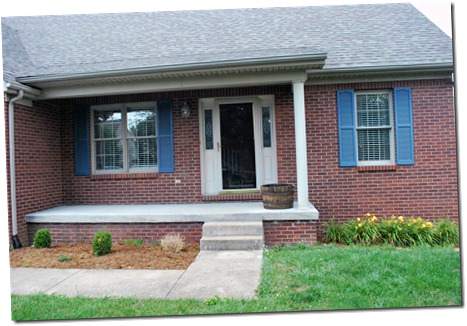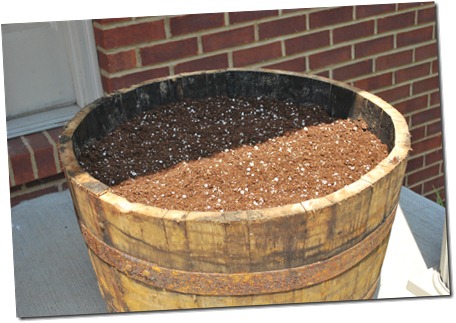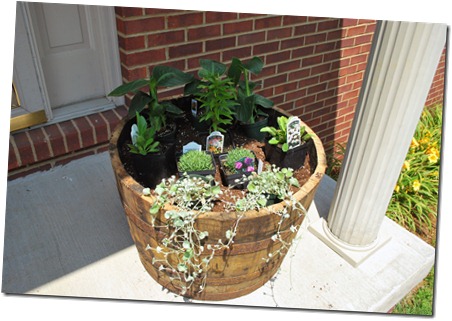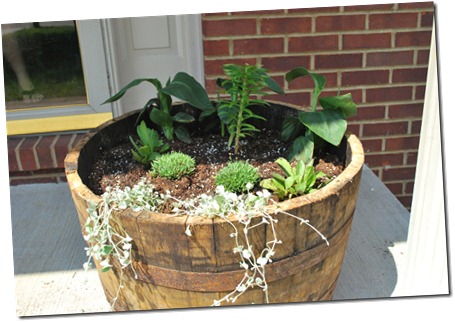Native Plants for Beginners - A HerKentucky Guest Post
Today, local garden enthusiast Retta Ritchie-Holbrook shares with us her efforts to fill her garden with native Kentucky plant species. Be sure to check out her fabulous list of resources, as well. Maybe my black thumb isn't so black after all! Maybe I just need to choose more native plants!
| One of the flowers from my friend - Wild Columbine |
My first true foray into gardening began when I bought a house and decided I wanted to make the landscape more appealing. My mother is an avid gardener and grows the most beautiful flowers. I guess you can say the desire to grow things runs in the family. The only problem was I didn’t seem to be very good at it. I would buy an array of bright, colorful plants only to watch them die. Sometimes, I would get lucky, and the plants would live for a few years until they became diseased, got pests or we would have a drought and I would miss watering them a few times because I was traveling for work. I would then have to yank them out and replace them. Gardening seemed like a lot of work and I simply didn’t have the time for it.
This process went on for a few years until a friend brought me some plants from her own garden and told me they were Kentucky native plants. I had not heard of native gardening at that time but those plants thrived and are still in my garden today. This encouraged me to learn more about native plants.
Native gardening or native landscaping is what its name implies: growing plants that are native to your area. I slowly started replacing my less hardy flowers with mostly native plants. They did so well that I began adding more and more flowerbeds with native plants and I’m currently in the process now of turning my backyard into mostly flowers and plants and less turf.
This process went on for a few years until a friend brought me some plants from her own garden and told me they were Kentucky native plants. I had not heard of native gardening at that time but those plants thrived and are still in my garden today. This encouraged me to learn more about native plants.
Native gardening or native landscaping is what its name implies: growing plants that are native to your area. I slowly started replacing my less hardy flowers with mostly native plants. They did so well that I began adding more and more flowerbeds with native plants and I’m currently in the process now of turning my backyard into mostly flowers and plants and less turf.
| In my garden, left to right: a.) Butterfly Weed & Purple Coneflowers b.) Celadine Poppy (Good in Shade) c.) Rattlesnake Plant |
Some benefits of native plants:
- They require less fertilizers and fewer pesticides.
- They require less water and often do better through droughts and other extreme types of weather.
- They provide shelter and food for wildlife. This also helps to manage the pests since wildlife feed on the pests, eliminating or greatly reducing the need for chemical pest control. I personally have not used pesticides for years.
- They are usually not invasive because they are a balanced part of the ecosystem and have natural predators.
- Native plants are beautiful, hardy and come in a wide variety of options. I recently added some native bushes, such as the spice bush, to encourage butterflies to breed there.
| One of my flowerbeds doing well even after the early summer drought. |
Because native plants are adapted to the local environment, they are easier to grow and create ecosystems for birds, pollinators and other beneficial critters. Now my yard is alive with butterflies, birds and more. I looked out the window just the other day to see a gold finch eating seeds out of the coneflower heads. I’ve seen several new species of birds and butterflies just this year alone that I had never seen in my yard before and I love it.
Left to right: a.) Lady Bug larva b.) Eastern Tiger Swallowtail |
Just a few of my favorite plants (Many of these have several varieties to choose from):
- Joe Pye Weed
- Ironweed
- Native Asters
- Cup Plant
- Goldenrods
- Garden Phlox
- Coneflowers
- Royal Catchfly
- Coreopsis
- Wild Columbine
- Black-eyed Susan
- Prairie Blazing Star
- Wild Onions
Places to visit for inspiration:
- The Salato Native Plant Programhttp://fw.ky.gov/navigation.aspx?cid=174&navpath=C130
- The Arboretum, State Botanical Garden of Kentuckyhttp://www.ca.uky.edu/arboretum/
- McConnell Springshttp://www.mcconnellsprings.org/nature.html
Online Resources for Native Plant Species:
- Wildflower Centerhttp://www.wildflower.org/collections/collection.php?collection=KY
- Kentucky Native Plant and Wildlife Blog - Tom Barneshttp://kentuckynativeplantandwildlife.blogspot.com/
- Betty Hall Photographer and Native Plant Extraordinairehttp://www.bettyhallphotography.com/blog/
Don’t miss her list of 25 Native Kentucky plants that attract birds and butterlieshttp://www.bettyhallphotography.com/resources/twenty-five-kentucky-native-plants-that-attract-birds-and-butterflies/
- Kentucky Native Plants: flickr grouphttp://www.flickr.com/groups/kynatives/
- My Kentucky Native Pinterest Boardhttp://pinterest.com/retta/ky-native-plants/
Where to buy native species:
- Shooting Star Nurseryhttp://shootingstarnursery.com/
I started my first full native plant flower bed by buying one of Shooting Star’s plant collectionshttp://shootingstarnursery.com/catalog/index.php?cPath=38&osCsid=a756ad61404d5290eb0d78a753ed07b4 - Dropseed Nurseryhttp://www.dropseednursery.com/
- Springhouse Gardenshttp://www.springhousegardens.com/
Native Plant Societies:
- The Kentucky Native Plant Societyhttp://www.knps.org/
- Wild Ones Lexington Chapterhttp://www.wildones.org/chapters/lexington/
How to Plant a Bourbon Barrel Planter
In my part of Kentucky, landscape designs often feature bourbon barrels pretty prominently. Cities' garden societies beautify their downtowns with the oak barrels, so I figure I’m not above it!
A few weeks ago, I got the opportunity to buy four half barrels for $10. Total. I jumped at the chance. For those of you not lucky enough to work in the industry, barrel halves are available for public purchase. Here’s one site I found – watch out for shipping. Maybe they’ll let you pick them up to avoid those charges?
Last weekend, my little sister moved into a new house – one that she and her husband hope will be their home for a very long time. While she assures me that landscaping and front porch furniture are in the works, I decided that a barrel planter was in order for a housewarming gift!
Bourbon barrels are more massive than you think! Each half weighs about 60 pounds, is about 18” tall and about 24” in diameter, tapering towards the bottom.
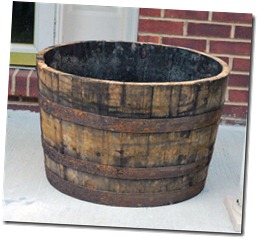
Each half barrel requires about 2.5 cubic feet of dirt or potting soil. I used Pro-Mix Ultimate Container Mix. Knowing the skill my sister has at keeping plants alive (I’m much like her), I chose to go with the planting medium that claims to hold on to water and contains a fertilizer already mixed in.
Before buying your plants, it’s good to assess the sun/shade situation of your planter. This particular location will get mostly full sun during the day, so I bought accordingly. I always find it helpful to lay out projects before committing to a final draft. Planting flowers is no different. So, here’s my rough draft – situating the still-potted plants around the space to see what works and doesn’t.
It turns out that my rough draft was pretty pleasing. My sister approved it, and I went to work planting the items. In the back, with the broad leaves, I planted 3 Tropical Yellow Canna Lilies. In the middle, as a sort of focus piece, I planted a Hardy Lily – it should grow a bit taller than the canna lillies and really stand out. On either side are two Shasta Daisies. In the middle are low-growing pink Dianthus. Finally, spilling over the front is a pretty plant with velvety leaves called Dichondra or Silver Falls.
As these grow, I’m hoping that they fill out and really shine on the front porch. If we all keep our fingers crossed and they survive my sister’s black thumb and the summer, all the varieties should come back next year, with the exception of the ornamentals up front.
It’s simple to make a nice, welcoming entrance to your home with bourbon barrel planters, plus it’s so completely Kentucky that it will be an instant conversation piece for any out-of-state visitors you might have!

